Protect and Survive
This booklet tells you how to make your home and family as safe as possible under nuclear attack


Foreword
If the country were ever faced with an immediate threat of nuclear war, a copy of this booklet would be distributed to every household as part of a public information campaign which would include announcements on television and radio and in the press. The booklet has been designed for free and general distribution in that event. It is being placed on sale now for those who wish to know what they would be advised to do at such a time.
May 1980
If Britain is attacked by nuclear bombs or by missiles, we do not know what targets will be chosen or how severe the assault will be.
If nuclear weapons are used on a large scale, those of us living in the country areas might be exposed to as great a risk as those in the towns. The radioactive dust, falling where the wind blows it, will bring the most widespread dangers of all. No part of the United Kingdom can be considered safe from both the direct effects of the weapons and the resultant fall-out.
The dangers which you and your family will face in this situation can be reduced if you do as this booklet describes.
Read this booklet with care
Your life and the lives of your family may depend upon it
Do as it advises
Keep it safely at hand
 Challenge to survival
Challenge to survival
Everything within a certain distance of a nuclear explosion will be totally destroyed. Even people living outside this area will be in danger from -
HEAT AND BLAST
FALL-OUT
Heat and Blast
The heat and blast are so severe that they can kill, and destroy buildings, for up to five miles from the explosion. Beyond that, there can be severe damage.
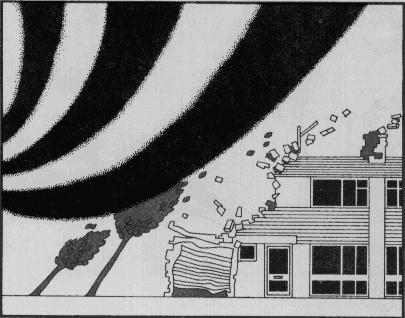
Fall-out
Fall-out is dust that is sucked up from the ground by
the explosion. It can be deadly dangerous. It rises high
in the air and can be carried by the winds for hundreds
of miles before falling to the ground.
The radiation from this dust is dangerous. It cannot be
seen or felt. It has no smell, and it can be detected
only by special instruments. Exposure to it can cause
sickness and death. If the dust fell on or around your
home, the radiation from it would be a danger to you and
your family for many days after an explosion. Radiation
can penetrate any material, but its intensity is reduced
as it passes through - so the thicker and denser the
material is, the better.

 Planning for survival
Planning for survival
Stay at Home
Your own local authority will best be able to help you
in war. If you move away - unless you have a place of
your own to go to or intend to live with relatives - the
authority in your new area will not help you with
accommodation or food or other essentials. If you leave,
your local authority may need to take your empty house
for others to use.
So stay at home.
Plan a Fall-out Room and Inner Refuge
The first priority is to provide shelter within your home against radioactive fall-out. Your best protection is to make a fall-out room and build an inner refuge within it.
First, the Fall-out Room
Because of the threat of radiation you and your family may need to live in this room for fourteen days after an attack, almost without leaving it at all. So you must make it as safe as you can, and equip it for your survival. Choose the place furthest from the outside walls and from the roof, or which has the smallest amount of outside wall. The further you can get, within your home, from the radioactive dust that is on or around it, the safer you will be. Use the cellar or basement if there is one. Otherwise use a room, hall or passage on the ground floor.

Even the safest room in your home is not safe enough, however. You will need to block up windows in the room, and any other openings, and to make the outside walls thicker, and also to thicken the floor above you, to provide the strongest possible protection against the penetration of radiation. Thick, dense materials are the best, and bricks, concrete or building blocks, timber, boxes of earth, sand, books, and furniture might all be used.
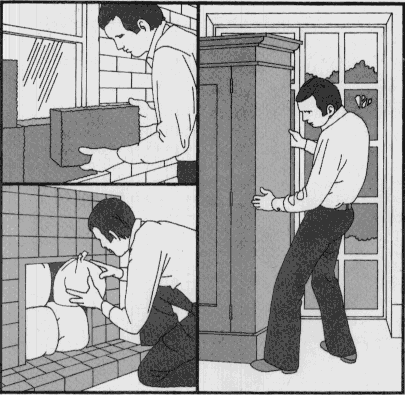
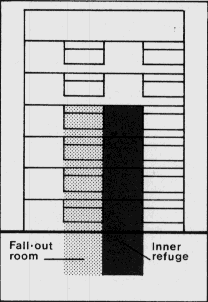 Flats
Flats
If you live in a block of flats there are other
factors to consider. If the block is five stories high or
more, do not shelter in the top two floors. Make
arrangements now with your landlord for alternative
shelter accommodation if you can, or with your neighbours
on the lower floors, or with relatives or friends.
If your flat is in a block of four storeys or less, the
basement or ground floor will give you the best
protection. Central corridors on lower floors will
provide good protection.
 Bungalows
Bungalows
Bungalows and similar single-storey homes
will not give much protection. Arrange to shelter with
someone close by if you can do so.
If not, select a place in your home that is furthest from
the roof and the outside walls, and strengthen it as has
been described.
Caravans
If you live in a caravan or other similar accommodation which provides very little protection against fall-out your local authority will be able to advise you on what to do.
Now the
Inner Refuge
Still greater protection is necessary in the fall-out room, particularly for the first two days and nights after an attack, when the radiation dangers could be critical. To provide this you should build an inner refuge. This too should be thick-lined with dense materials to resist the radiation, and should be built away from the outside walls.
Here are some ideas:
1. Make a 'lean-to' with sloping doors taken from rooms above or strong boards rested against an inner wall. Prevent them from slipping by fixing a length of wood along the floor. Build further protection of bags or boxes of earth or sand - or books, or even clothing - on the slope of your refuge, and anchor these also against slipping. Partly close the two open ends with boxes of earth or sand, or heavy furniture.

2. Use tables if they are large enough to provide you all with shelter. Surround them and cover them with heavy furniture filled with sand, earth, books or clothing.

3. Use the cupboard under the stairs if it is in your fall-out room. Put bags of earth or sand on the stairs and along the wall of the cupboard. If the stairs are on an outside wall, strengthen the wall outside in the same way to a height of six feet.

PLAN YOUR SURVIVAL KIT
Five essentials for survival in your Fall-out Room
1 Drinking Water
You will need enough for the family for fourteen days.
Each person should drink two pints a day - so for this
you will need three and a half gallons each.
You should try to stock twice as much water as you are
likely to need for drinking, so that you will have enough
for washing. You are unlikely to be able to use the mains
water supply after an attack - so provide your drinking
water beforehand by filling bottles for use in the fall-out
room. Store extra water in the bath, in basins and in
other containers.
Seal or cover all you can. Anything that has fall-out
dust on it will be contaminated and dangerous to drink or
to eat. You cannot remove radiation from water by boiling
it.

2 Food
Stock enough food for fourteen days.
Choose foods which can be eaten cold, which keep fresh,
and which are tinned or well wrapped. Keep your stocks in
a closed cabinet or cupboard.
Provide variety. Stock sugar, jams or other sweet foods,
cereals, biscuits, meats, vegetables, fruit and fruit
juices. Children will need tinned or powdered milk, and
babies their normal food as far as is possible. Eat
perishable items first. Use your supplies sparingly.

3 Portable Radio and Spare Batteries
Your radio will be your only link with the outside world. So take a spare one with you if you can. Keep any aerial pushed in. You will need to listen for instructions about what to do after the attack and while you remain in your fall-out room.

4 Tin Opener, Bottle Opener, Cutlery and Crockery
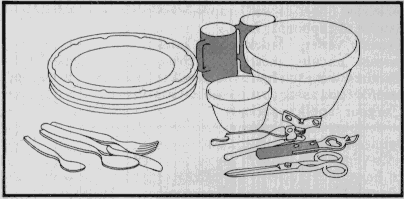
5 Warm Clothing

And don't forget to take this booklet with you
These further items will also be useful in the Fall-out Room:
6. Bedding, sleeping bags

7. Portable stove and fuel, saucepans

8. Torches with spare bulbs and batteries, candles, matches

9. Table and chairs

10. Toilet articles soap, toilet rolls, bucket and plastic bags (see Sanitation)

11. Changes of clothing

12. First aid Kit - with household medicines and prescribed medicines. And at least aspirins or similar tablets, adhesive dressings, cotton wool, bandages, disinfectant, ointment, including 'Vaseline'

13. Box of dry sand, cloths or tissues for wiping plates and utensils

14. Notebook and pencils for messages

15. Brushes, shovels and cleaning materials, rubber or plastic gloves, dustpan and brush

16. Toys and magazines

17. Clock (mechanical) and calendar

Sanitation
You will need special sanitation arrangements because there will be no water to waste in lavatories.
Keep these items in the Fall-out Room:
 Containers such as
polythene buckets, fitted with covers and - if possible -
improvised seats.
Containers such as
polythene buckets, fitted with covers and - if possible -
improvised seats.
 Polythene bag linings for emptying the
containers.
Polythene bag linings for emptying the
containers. Strong disinfectant
and toilet paper.
Strong disinfectant
and toilet paper.Keep these items just outside the Fall-out Room:
 A dustbin for the
temporary storage of sealed bags of waste matter
A dustbin for the
temporary storage of sealed bags of waste matter
 A
second dustbin for food remains, empty tins and other
rubbish
A
second dustbin for food remains, empty tins and other
rubbishIf you have only one dustbin, use that for toilet waste only. Put all other rubbish in plastic bags or paper until you can take it outside the house.
Limit the Fire Hazards
As you plan the fall-out room and the inner refuge you
need also to limit as far as you can the dangers from
heat and blast to the rest of the house. Though the heat
could not ignite the bricks and stone of your home it
could set alight the contents by striking through
unprotected windows.
There are things you can do now to lessen these risks -
Remove anything which may ignite and burn easily (paper
and cardboard, for example) from attic and upper rooms
where fire is most likely.
Remove net curtains or thin materials from windows - but
leave heavy curtains and blinds as these can be drawn
before an attack as protection against flying glass.
Clear out old newspapers and magazines.
Coat windows inside with diluted emulsion paint of a
light colour so that they will reflect away much of the
heat flash, even if the blast which will follow is to
shatter them.
If you have a home fire extinguisher - keep it handy.
Keep buckets of water ready on each floor.
Remove boxes, firewood and materials which will burn
easily which are close to the outside of the house.
Keep any remaining doors closed to help prevent the
spread of fire.
In an attack, damage to gas, oil and electricity systems
could add serious fire and other hazards. All responsible
members of your family should therefore know where and
how to turn off gas and electricity at the mains, all gas
pilot lights and oil supplies.

 Protect and survive
Protect and survive
What you have read so far tells you how to prepare to
face a nuclear explosion.
What follows tells you how to use the protection you have
provided.
First - Know the Warning Sounds:
THE ATTACK WARNING

When an air attack is expected the sirens will sound a
rising and falling note.
The warning will also be broadcast on the radio.
THE FALL-OUT WARNING



When there is danger from fall-out you will hear three loud bangs or three whistles in quick succession.
THE ALL-CLEAR
![]()
When the immediate danger from both air attack and fall-out has passed, the sirens will sound a steady note.
What to do on hearing an Attack Warning:

At home
If you are at home you should:
Send the children to the fall-out room.
Turn off the gas and electricity at the mains; turn off
all pilot lights. Turn off oil supplies.
Close stoves, damp down fires.
Shut windows, draw curtains.
Go to the fall-out room.
At work or elsewhere
If you can reach home in a couple of minutes try to do
so.
If your are at work, or elsewhere, and cannot reach home
within a couple of minutes, take cover where you are or
in any nearby building.
In the open
If you are in the open and cannot get home within a couple of minutes, go immediately to the nearest building. If there is no building nearby and you cannot reach one within a couple of minutes, use any kind of cover, or lie flat (in a ditch) and cover the exposed skin of the head and hands.

Light and heat from an explosion will last for up to twenty seconds, but blast waves may take up to a minute to reach you. If after ten minutes there has been no blast wave, take cover in the nearest building.
What to do after the Attack:
After a nuclear attack, there will be a short period before fall-out starts to descend. Use this time to do essential tasks. This is what you should do.
 Do not
smoke.
Do not
smoke.
Check that gas, electricity and other fuel supplies and
all pilot lights are turned off.
Go round the house and put out any small fires using
mains water if you can.
If anyone's clothing catches fire, lay them on the floor
and roll them in a blanket, rug or thick coat.
If the mains water is still available also replenish water reserves. Then turn off at mains.
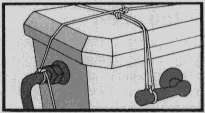 Do not flush
lavatories, but store the clean water they contain by
taping up the handles or removing the chains
Do not flush
lavatories, but store the clean water they contain by
taping up the handles or removing the chains
If the water supply is interrupted extinguish water heaters and boilers (including hearth fires with back boilers). Turn off all taps.
Check that you have got your survival kit at hand for the fall-out room. (See the list of survival items.)
If there is structural damage from the attack you may have some time before a fall-out warning to do minor jobs to keep out the weather using curtains or sheets to cover broken windows or holes.
If there is time, help neighbours in need, but listen for the fall-out warning and be ready to return to the fall-out room.
What to do on hearing the Fall-out Warning:



(Remember you may bear a fall-out warning without hearing an explosion.)
In the open
If you are out of doors, take the nearest and best available cover as quickly as possible, wiping all the dust you can from your skin and clothing at the entrance to the building in which you shelter.
At home

All at home must go to the fall-out room and stay inside the inner refuge, keeping the radio tuned for Government advice and instructions.
Stay in your refuge
The dangers will be so intense that you may all need
to stay inside your inner refuge in the fall-out room for
at least forty-eight hours. If you need to go to the
lavatory, or to replenish food or water supplies, do not
stay outside your refuge for a second longer than is
necessary.
After forty-eight hours the danger from fall-out will
lessen -but you could still be risking your life by
exposure to it. The longer you spend in your refuge the
better. Listen to your radio.
DO NOT GO OUTSIDE until the radio tells you it is safe to
do so.
Later on
Visits outside the house may at first be limited to a few minutes for essential duties. These should be done by people over thirty where possible. They should avoid bringing dust into the house, keeping separate stout shoes or boots for outdoors if they can, and always wiping them.
Casualties
You may have casualties from an attack, which you will
have to care for, perhaps for some days, without medical
help. Be sure you have your first aid requirements in
your survival kit. (See the list
of survival items.)
Listen to your radio for information about the services
and facilities as they become available and about the
type of cases which are to be treated as urgent.
If a death occurs while you are confined to the fall-out
room place the body in another room and cover it as
securely as possible. Attach an identification.
You should receive radio instructions on what to do next.
If no instructions have been given within five days, you
should temporarily bury the body as soon as it is safe to
go out, and mark the spot.
On hearing the ALL-CLEAR
This means there is no longer an immediate danger from air attack and fall-out and you may resume normal activities.
 Your action check list
Your action check list
Here is a check list, which reminds you of the actions
you must take to provide the protection outlined in this
booklet.
Use the check list systematically, ticking off each item
as you deal with it. This will help you to remember all
the things you must do.